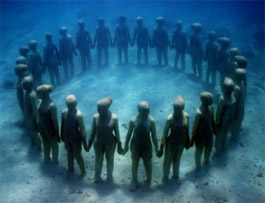
The largest underwater museum in the world is in Mexico
 |
Today, four sculptures were lowered into the Caribbean Sea off the Yucatán Peninsula. Hundreds of other figures are expected to follow, which will also be placed within the local national park.
The sculptures are made of pH-neutral concrete, which, the creators hope, will attract algae and other representatives of marine life, thus allowing for a presentation of the local ecosystem alongside the artworks.
One of the goals of the project, according to park director Jaime González, is to reduce the burden on the natural environment of the coral reefs, which have been damaged by hurricanes and human activity, and to attract tourists to another part of the park where the underwater museum will be created.
If fewer visitors come among the corals, they will have a better chance of recovery. The park receives about 750,000 visitors annually, with about 450,000 people coming to Punta Nizuc, an area of four hectares that is most burdened, González noted.
The sculptures are designed to be durable and have no harmful impact on the environment.
"Everything is happening very quickly. Within just two weeks, green algae appeared on the sculptures," said artist Jason deCaires Taylor, who is collaborating on the project.
The idea of an underwater museum is not new; several already exist worldwide. However, this project is said to be unique in its scale and concept.
The English translation is powered by AI tool. Switch to Czech to view the original text source.
0 comments
add comment












